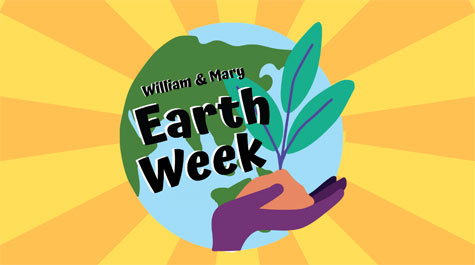W&M, other universities collaborate on virtual Earth Week
The William & Mary community celebrated Earth Week virtually this spring, working with other Virginia universities to offer events accessible to the public through multiple online platforms.
Earth Week is an annual celebration coordinated by W&M Sustainability, coinciding with Earth Day in April. In previous years, the week’s scheduled programming culminated in a public festival with favorite events including a reading of Dr. Seuss’ “The Lorax” and Homebreweroo, a student music showcase sponsored by AMP.
The COVID-19 pandemic led to the pivot to virtual events this year. It resulted in new forms of digital collaboration, all the while preserving some favorite campus traditions.
“This Earth Week was a huge success,” said Calandra Waters Lake, W&M director of sustainability. “It brought people together from across the state, and that was all due to the students of our Earth Week Committee.
Combining impacts, efforts and audiences, seven Virginia universities — W&M, University of Virginia, Washington and Lee University, Virginia Commonwealth University, Radford University, Virginia Tech and George Mason University — partnered to share, borrow and cross-promote events. W&M’s Office of Sustainability’s website served as the online hub. Most events were hosted through video services such as Zoom, offering a way for people to engage virtually and access a variety of programming.
“Transitioning to a virtual event was an exciting challenge for our whole committee,” said Greta Mattheis ’21, one of two student co-chairs for the W&M Earth Week Committee.
“We really enjoyed teaming up with other W&M departments and getting creative with what we could do with the week. One of the highlights for me was getting the chance to collaborate with other Virginia universities and share ways we could work together to make a more impactful Earth Week.”
Community members took the changes in stride, as reflected in event attendance numbers. Registration reached capacity for Kitsbow CEO David Billstrom’s talk offered through W&M’s Office of Community engagement. Other events attracted members from different university communities, with W&M students attending events such as George Mason University’s “Freedom in a Can,” according to attendance records.
Departments across campus contributed to W&M Earth Week. W&M Libraries released a virtual guide containing sustainability-related research sources and a reading list with Earth Day-themed selections. Dining published a plant-based nutrition series for a more planet-friendly diet. Outdoor Recreation posted “leave no trace” educational videos to the Sustainability YouTube page throughout the week.
W&M Earth Day Festival traditions continued this year. On April 25, Provost Peggy Agouris read “The Lorax” on YouTube. Later in the day, Homebreweroo continued with a concert video comprised of multiple student performance groups, also posted to YouTube. Approximately 150 people watched the stream.
“It's difficult to match the sense of community we would have achieved with busy events on campus, but everyone's resilient events-planning and adaptability has inspired me,” said Gabrielle Jawer ’22, student co-chair for the Earth Week Committee.
The inter-university efforts that sustained Earth Week 2020 first came out of the William & Mary-University of Virginia Climate Action Partnership announced in December.
The two universities have jointly committed to reach campus carbon neutrality by 2030. This commitment entails information and resource-sharing on carbon neutrality progress, engaging the universities and surrounding communities in the process and supporting other higher educational institutions in Virginia in their carbon reduction goals. That spirit of collaboration continued as Earth Week organizers adapted campus sustainability programming for the COVID-19 situation.
“The seed idea of a multi-university Earth Week collaboration was a spinoff of the Climate Action Partnership,” said Waters Lake. “That open channel led to additional ways to connect and collaborate across universities in ways that made sense and were beneficial to many.”
 Skip to main content
Skip to main content

